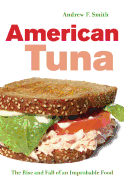
Tuna, once valued more as a source of oil than of sustenance, did not become standard cuisine until wartime rationing raised its profile in the American diet. Andrew F. Smith (Potato: A Global History) chronicles tuna's transformation from immigrant gruel to the most commonly consumed fish in the country in the entertaining American Tuna.
Smith pinpoints the rise of interest in tuna to the enthusiasm of sport fishermen off the Pacific coast, but it was not until 1910 that canned albacore piqued public interest--and only when its flavor and smell were adulterated to resemble white-fleshed chicken (thus "Chicken of the Sea"). Tuna's popularity rose during the two world wars, when rationing created an international demand for alternative protein sources. Overconsumption and overfishing drove industry fishermen to pillage tuna-rich stores off the coast of South America, forcing the U.S. government to create protective economic policies and foreign alliances that turned the tuna market into a parallel of Big Oil, with Americans dependent on foreign suppliers to meet their increasing demand.
Smith's thoroughly researched history forces us to consider the larger picture of how consumption affects the renewability of food sources and how economic power can damage more than sustain. If American Tuna stimulates a broader discussion on the problems of food production as a whole, Smith will have achieved a major victory. --Nancy Powell, freelance writer

